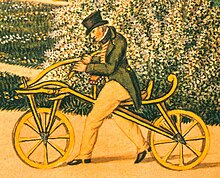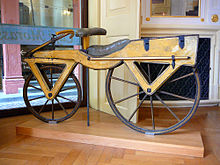Karl Drais



Karl Drais (April 29, 1785 – December 10, 1851) was a German inventor and invented the Laufmaschine ("running machine"), also later called the velocipede, draisine (English) or "draisienne" (French), also nick-named the dandy horse. This incorporated the two-wheeler principle that is basic to the bicycle and motorcycle and was the beginning of mechanized personal transport. Drais also invented the earliest typewriter with a keyboard in 1821, later developed into an early stenograph machine, and a wood-saving cooker including the earliest hay chest.
Biography
Karl Drais was born in Karlsruhe with the aristocratic title Karl Wilhelm Friedrich Christian Ludwig, Freiherr Drais von Sauerbronn, but as he was a democrat, he did not use his title. His father was the chief judge of Baden, Karl Wilhelm Friedrich Ludwig von Drais. His mother was Margarete Ernestine von Kaltenthal. The Margrave of Baden, Carl Friedrich von Baden, was one of Karl's godfathers.
From 1803 to 1805, Drais studied architecture, agriculture and physics at the University of Heidelberg.
He joined the civil service as a forestry official, worked as a teacher in his uncle's private forestry institution, and in 1810 received the title of chief forester, but was not yet assigned a commensurate position. One year later he was suspended from active service, but continued to receive his salary so that he could devote more time to his inventions.
Drais's most influential invention was the Laufmaschine or velocipede, the earliest form of a bicycle, yet without pedals. His first reported ride, from Mannheim to the "Schwetzinger Relaishaus" (a coaching inn, located in "Rheinau", today a district of Mannheim) took place on June 12, 1817. In the same year, he undertook his second trip, from Gernsbach to Baden-Baden, and others.
On January 12, 1818, Drais was awarded a grand-ducal privilege (Großherzogliches Privileg) to exploit his invention. Baden had no patent law at that time. Grand Duke Karl also appointed Drais Professor of Mechanics. This was merely an honorary title, not related to any university or other institution. Drais retired from the civil service and continued to receive his salary as a kind of inventor's pension.
Disaster overtook Drais, when a political murder was followed by the beheading of the murderous student Ludwig Sand in 1820. Drais' father as the highest judge of Baden had not pleaded for pardon, and his son was mobbed by the student partisans eveywhere in Germany. Therefore, from 1822 to 1827, Drais emigrated to Brazil as a land surveyor on the facenda of Georg Heinrich von Langsdorff, yet returned to Mannheim..
H. E. Lessing has shown by circumstantial evidence that the climate anomaly of 1816 Year Without a Summer due to the eruption of Tambora, which impaired transportation in Europe by crop failure and starvation of horses, was the cause of Drais's invention of the velocipede.[1]
Drais died in his home town of Karlsruhe in 1851 penniless, after the Prussians had suppressed the revolution of 1849 in Baden and seized his pension completely to pay for the "costs of revolution".
See also
Bibliography
- Hans-Erhard Lessing: Karl Drais - zwei Räder statt vier Hufe. G. Braun Buchverlag, Karlsruhe 2010. ISBN 978-3-7650-8569-7
- Hans-Erhard Lessing: Automobilität – Karl Drais und die unglaublichen Anfänge. Maxime-Verlag, Leipzig 2003. ISBN 3-931965-22-8
- Hermann Ebeling: Der Freiherr von Drais: das tragische Leben des „verrückten Barons“. Ein Erfinderschicksal im Biedermeier. Braun, Karlsruhe 1985. ISBN 3-7650-8045-4
- Heinz Schmitt: Karl Friedrich Drais von Sauerbronn: 1785–1851; ein badischer Erfinder; Ausstellung zu seinem 200. Geburtstag; Stadtgeschichte im Prinz-Max-Palais, Karlsruhe, 9. März-26. Mai 1985; Städt. Reiss-Museum Mannheim, 5. Juli–18. August 1985. Stadtarchiv Karlsruhe, Karlsruhe 1985.
- Michael Rauck: Karl Freiherr Drais von Sauerbronn: Erfinder und Unternehmer (1785–1851). Steiner, Stuttgart 1983. ISBN 3-515-03939-2
- Karl Hasel: Karl Friedrich Frhr. Drais von Sauerbronn, in Peter Weidenbach (Red.): Biographie bedeutender Forstleute aus Baden-Württemberg. Schriftenreihe der Landesforstverwaltung Baden-Württemberg, Band 55. Herausgegeben vom Ministerium für Ernährung, Landwirtschaft und Umwelt Baden-Württemberg. Landesforstverwaltung Baden-Württemberg und Baden-Württembergische Forstliche Versuchs- und Forschungsanstalt, Stuttgart und Freiburg im Breisgau 1980, pp. 99–109.
External links
- "Brimstone and Bicycles" by Mick Hamer of New Scientist, 29 January 2005
- www.karldrais.de by S. Fink and H. E. Lessing (choose English version)
- karl-drais.de of ADFC Mannheim, providing a short biography in more than 15 languages
- Karl Drais in Baden-Baden by Hans-Erhard Lessing
- Article in the Neue Deutsche Biographie by Sigfrid von Weiher
